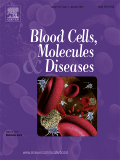Blood Cells, Molecules and Diseases
Blood Cells, Molecules and Diseases is a comprehensive field of study within medicine and biology that focuses on understanding the various components of blood, their functions, and the diseases that affect them. This field encompasses the study of red blood cells, white blood cells, platelets, hemoglobin, and other molecules such as enzymes, antibodies, and hormones that play crucial roles in the physiological and pathological processes of the blood system.
Red Blood Cells (Erythrocytes)[edit | edit source]
Red blood cells (RBCs), also known as erythrocytes, are the most abundant cells in human blood. Their primary function is to carry oxygen from the lungs to the body's tissues and to transport carbon dioxide back to the lungs for exhalation. RBCs contain hemoglobin, a complex protein that binds oxygen and gives blood its red color.
White Blood Cells (Leukocytes)[edit | edit source]
White blood cells (WBCs), or leukocytes, are part of the immune system and play a key role in defending the body against both infectious disease and foreign materials. Five major types of leukocytes exist: neutrophils, lymphocytes, monocytes, eosinophils, and basophils, each with its own function in immune response.
Platelets (Thrombocytes)[edit | edit source]
Platelets, also known as thrombocytes, are small, colorless cell fragments in the blood that form clots and stop or prevent bleeding. Platelets play a crucial role in hemostasis and are involved in the repair of damaged blood vessels.
Blood Molecules[edit | edit source]
Blood contains numerous molecules that perform a wide range of functions. These include:
- Hemoglobin: A protein in red blood cells that carries oxygen. - Antibodies: Part of the immune system, they identify and neutralize foreign objects like bacteria and viruses. - Hormones: Chemical messengers that transport signals from one cell to another to coordinate bodily functions. - Enzymes: Catalysts that speed up chemical reactions in the body, including those involved in blood clotting and digestion.
Blood Diseases[edit | edit source]
Diseases of the blood and blood components can affect any of the cells, proteins, and other molecules in the blood. Common blood diseases include:
- Anemia: A condition in which there is a deficiency of red cells or of hemoglobin in the blood, resulting in pallor and weariness. - Leukemia: A type of cancer found in your blood and bone marrow, caused by the rapid production of abnormal white blood cells. - Hemophilia: A rare disorder in which your blood doesn't clot normally because it lacks sufficient blood-clotting proteins (clotting factors). - Thrombosis: The formation of a blood clot inside a blood vessel, obstructing the flow of blood through the circulatory system.
Research and Treatment[edit | edit source]
Advancements in the field of blood cells, molecules, and diseases have led to significant improvements in the diagnosis, treatment, and prevention of blood disorders. Research is ongoing to better understand the genetic, molecular, and environmental factors that contribute to these conditions. Treatment options vary depending on the specific disease but may include medication, blood transfusions, bone marrow transplants, and lifestyle changes.
Navigation: Wellness - Encyclopedia - Health topics - Disease Index - Drugs - World Directory - Gray's Anatomy - Keto diet - Recipes
Search WikiMD
Ad.Tired of being Overweight? Try W8MD's physician weight loss program.
Semaglutide (Ozempic / Wegovy and Tirzepatide (Mounjaro / Zepbound) available.
Advertise on WikiMD
WikiMD is not a substitute for professional medical advice. See full disclaimer.
Credits:Most images are courtesy of Wikimedia commons, and templates Wikipedia, licensed under CC BY SA or similar.Contributors: Prab R. Tumpati, MD

